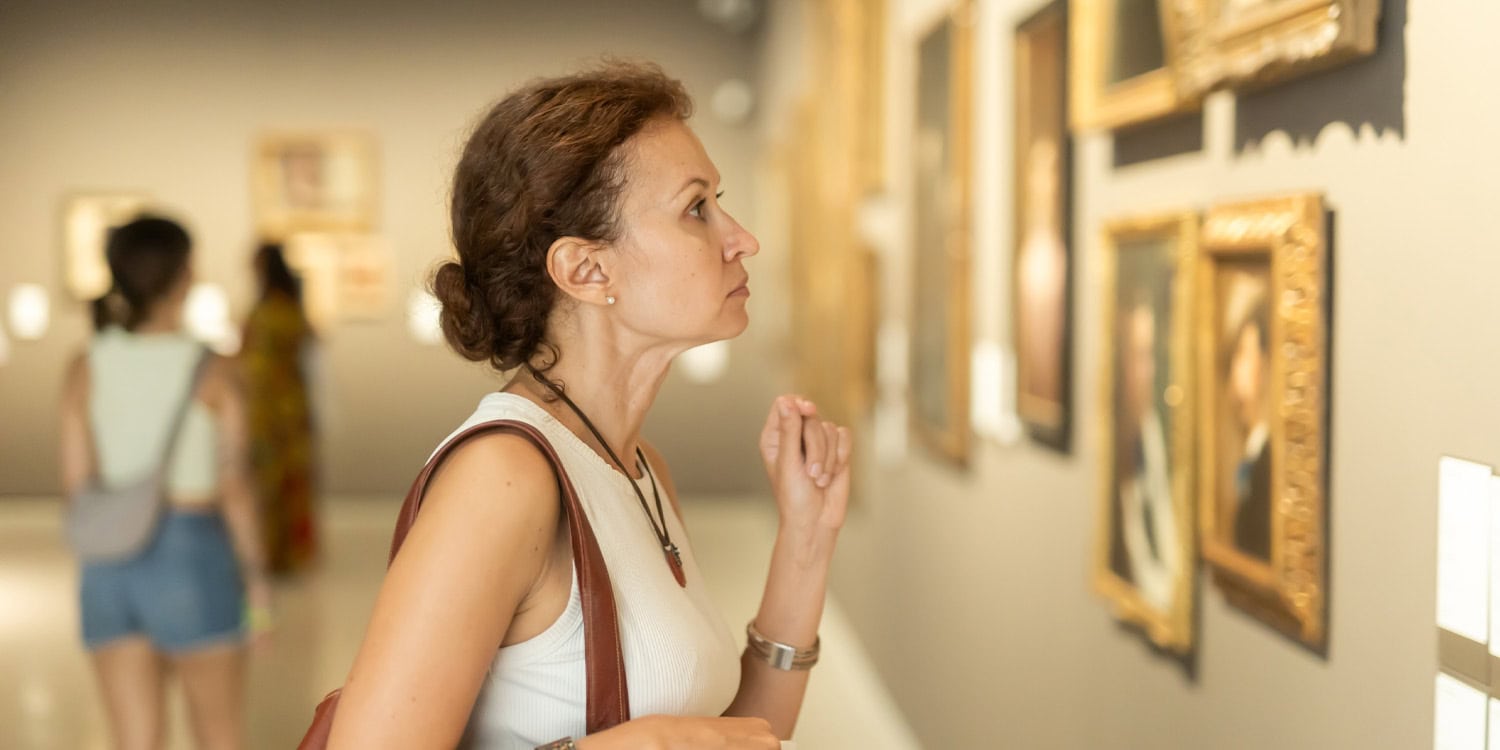People are more willing to engage with negative content when it is presented as art rather than as a straightforward photograph, according to new research published in the Proceedings of the National Academy of Sciences. The researchers discovered that artworks depicting distressing scenes held viewers’ attention for longer periods and were often chosen over similar non-art images. This work suggests that art can serve as a powerful tool for communicating difficult or unpleasant information in a way that makes it more accessible.
Throughout history, artists have explored themes of death, suffering, and violence. Think of “memento mori” artworks that remind us of our mortality, or powerful paintings like Caravaggio’s “Medusa” and Frida Kahlo’s unflinching self-portraits depicting chronic pain. These works, though potentially disturbing, captivate audiences and have become iconic.
A team of researchers set out to understand this phenomenon, specifically focusing on whether art makes us more willing to engage with negative content. They wanted to test if people show a stronger interest in seeing negative situations depicted in paintings compared to similar situations shown in photographs. Beyond simply measuring interest, the researchers also wanted to understand the psychological reasons behind this potential preference for art, exploring what motivates us to engage with negative content in different forms.
“I’m curious about why people engage with negative content, from true crime to accident videos. Research on morbid curiosity suggests that negative information serves important functions—it helps us gain knowledge, understand emotions, and connect with others—primarily because it is grounded in reality and relevant to real-life,” said study author Yagmur Ozbay, a PhD candidate at the University of Amsterdam.
“This creates an interesting challenge for art, which often abstracts reality rather than depicting it directly. If real-world content is inherently more informative and socially relevant, why does art hold such a dominant role in portraying negative themes?”
“While many assume it’s intuitive that people would prefer engaging with negative content through art, I questioned whether this was truly the case from a functional perspective. This led me to investigate whether, when given the choice, people actually prefer engaging with negative content—specifically moral transgressions involving harm and violence—through art or non-art, and why.”
The researchers conducted a series of five online experiments. They started by selecting ten pairs of images. Each pair consisted of a painting and a photograph that depicted the same negative situation involving a moral violation – things like violence or injustice. For example, one pair might show a painting and a photograph of people fighting. They also created a set of image pairs showing positive moral actions, like caring for others, for use in one of their studies.
The researchers selected paintings by well-known artists and then identified photographs depicting similar scenes to ensure content comparability. It was important that the photographs were seen as less artistic than the paintings, so they conducted a preliminary study to confirm this. They ensured that both the paintings and photographs in each pair were seen as equally representative of the moral content they were meant to portray. In the experiments, the paintings were presented as “a painting selected to be displayed in an art gallery,” while the photographs were described as “a photo selected to illustrate a news article.”
The participants were recruited online through a platform called Prolific. All participants were native English speakers, had a high rating for completing studies reliably, and had not taken part in any similar studies before. Across the five experiments, over a thousand people participated.
In the first experiment, 200 participants were divided into two groups. One group was told they would be looking at descriptions of paintings, and the other group was told they would be looking at descriptions of photographs. For each description, participants were asked if they wanted to see the image. The descriptions covered both positive and negative situations. The researchers measured whether people chose to see the images and how long they looked at them if they chose “yes.”
The second experiment involved 119 participants. This time, for each negative situation, participants were given a choice: did they want to see the painting or the photograph? Again, the researchers tracked which type of image people chose and how long they looked at it.
In the third set of experiments (Studies 3A and 3B), participants were shown both paintings and photographs of negative situations. In one version (3A), everyone saw both types of images. In another version (3B), some participants only saw paintings, and others only saw photographs. After viewing each image, participants rated their experience. They answered questions about their emotional responses like distress, compassion, and feeling moved. They also rated how aesthetically pleasing and thought-provoking they found the image, and whether it gave them a realistic or original perspective, among other things. The researchers still measured how long participants spent looking at each image.
The final experiment, Study 4, had three parts and involved 191 participants. First, participants were presented with descriptions of negative situations paired with either a painting or a photograph label, and they chose whether or not they wanted to see the image, but they didn’t see it yet. Second, before seeing any images, they were asked to rate how they expected viewing each image (painting or photograph) would affect them in terms of various motivations, such as providing a realistic perspective or being emotionally costly. Finally, in the third part, they were shown the images they had chosen to see earlier. Researchers again tracked viewing time and also asked participants if the images were more or less interesting than they had expected.
After analyzing the data from all five experiments, the researchers found a clear pattern. People showed a stronger preference for engaging with negative content when it was presented as art. In the first study, participants were more likely to choose to view paintings depicting negative situations compared to photographs of similar situations. Interestingly, this preference for art was not seen when the content was positive.
In the second study, when participants were directly asked to choose between a painting and a photograph of the same negative event, they chose the painting more often than the photograph. While the fourth study did not replicate the choice preference, the researchers believe this was due to a change in the experimental design that removed the immediate feedback of viewing an image after choosing it.
Across all five studies, a consistent finding emerged: people spent more time looking at artworks depicting negative content than at photographs of similar content. This was true whether participants chose to see the images or were shown them automatically.
“Our study provides empirical evidence that people are more likely to engage with negative content when it is presented through art rather than matched control photographs,” Ozbay told PsyPost. “Participants not only chose to engage with this content more frequently but also spent more time with it. The content specifically involved scenes of violence and harm, with participants making engagement choices based on identical descriptions across art and non-art formats—for example, ‘Police violently restrain a woman at a gathering,’ ‘A young boy is forced to work in a factory,’ and “Guerrilla soldiers attack civilians in a village.’”
“These scenarios reflect real-world social issues like child labor, war, and police violence. The fact that participants engaged with these depictions more often—and for longer—suggests that art may be a powerful tool for sustaining attention on critical yet emotionally challenging issues that people might otherwise avoid. This has important implications for artists, educators, journalists, and activists who seek to communicate difficult topics and foster public awareness and action.”
To understand why people preferred art for negative content, the researchers examined the ratings from Studies 3A and 3B. They discovered that participants consistently rated the artworks as more aesthetically pleasing than the photographs. Furthermore, viewing negative content in art form was seen as less emotionally draining or “costly” compared to viewing it in photographs. Artworks also provided a less realistic perspective than the photographs. However, there were no significant differences in how thought-provoking, original, or moving the art and non-art images were perceived to be.
In Study 4, when examining motivations, the researchers found that people were more likely to choose to engage with negative content if they expected it to be thought-provoking, aesthetically pleasing, and offer an original perspective – regardless of whether it was art or a photograph. However, the expected emotional cost played a significant role in people’s decisions to avoid content, especially when it was presented as a photograph. In other words, people were less deterred by the potential emotional difficulty of engaging with negative content if they believed it was art.
These findings suggest that art acts as a kind of buffer when we engage with difficult or negative subjects. The aesthetic qualities of art and the sense that we are in a slightly removed, “as-if” world when experiencing art, may reduce the emotional impact of negative content, making it more approachable. This reduced emotional cost, combined with the appeal of aesthetic appreciation and thought-provoking perspectives, makes people more willing to explore negative themes through art than through non-art media.
“One surprising finding was that the motivations driving engagement with negative content—such as seeking aesthetic value, thought-provoking material, and an original perspective—were not exclusive to art,” Ozbay explained. “This is important because while our experimental design, which strictly categorizes art and non-art, strengthens the validity of our findings, such a black-and-white distinction may not always translate to real-life experiences.”
“This result suggests that engagement is not about whether something is strictly labeled as ‘art’ but rather whether it creates expectations of artistic qualities. This means our findings don’t imply that news photography should be replaced by paintings, but rather that incorporating artistic elements into various formats could help sustain engagement with difficult topics without requiring every representation to be classified as ‘art.’”
The researchers acknowledge that their study focused solely on visual art. They point out that different forms of art, like literature or music, might create similar or different effects, which is an interesting avenue for future research. Also, all the experiments were conducted online. While this setting mirrors how we often encounter images in our daily digital lives and allowed for controlled experiments, exploring how people engage with negative art in real-world settings like museums would be valuable.
Looking ahead, the researchers are interested in exploring the longer-term effects of this increased engagement with negative content through art. “I’m interested in expanding this research to explore what this increased engagement can offer,” Ozbay said. “If people are more willing to engage with difficult yet important social issues through the arts, could this lead to greater awareness, foster empathy, or even inspire action? We’ve only just begun to explore these possibilities, and I’m excited to see what lies ahead.”
“I’m excited to discuss the arts beyond beauty and aesthetics. Because we often associate art with these qualities, some may dismiss the idea that art can present real-world issues, either seeing it as outside art’s purpose or believing these issues are too important to be represented artistically. I hope this study encourages people to think about the role of art beyond aesthetics.”
“Art is not just about beauty—it’s a tool for processing, understanding, and confronting difficult aspects of life,” Ozbay concluded. “Artists use it to communicate real stories, perspectives, and emotions; we engage with it and, through it, connect with culture, history, and identities.”
The study, “Art promotes exploration of negative content,” was authored by Yagmur Ozbay, Eftychia Stamkou, and Suzanne Oosterwijk.




